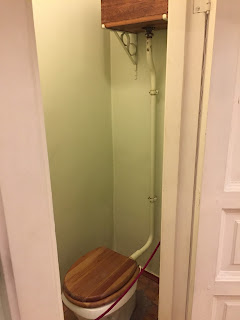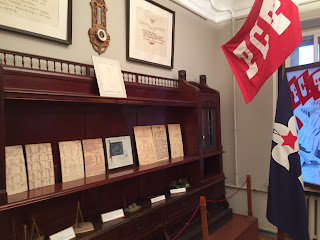183. Sergei Kirov Museum
Sergei Mironovich Kirov (1886-1934) was a prominent Bolshevik leader in Russia during the first two decades of the twentieth century, and later the head of the Communist party organization in Leningrad in the 1920s and 1930s. As such, he was the top political leader in the city and was a close ally of Josef Stalin. Kirov was assassinated in 1934 in Smolny, an event which Stalin used as justification to launch the Great Purges of 1936-1938.
The apartment in St. Petersburg where Kirov lived for the last eight years of his life - in a circa 1911-1914 building complex - is located in the center of Petrogradsky Island. It was turned into the Sergei Kirov Museum in 1955 (the museum had previously been established in a different location in 1938, shortly after his assassination). I was very interested to see the living conditions for the social and political elite in Leningrad during the early Soviet period. Kirov and his wife were given substantially more space than the typical Leningrader would have enjoyed; the apartment includes a study, library, dining room, bedroom, small workshop, two halls, a kitchen, a housemaid's room, and two lavatories. I especially enjoyed seeing Kirov's library with 20,000 volumes (many of which were mandatory reading for state officials, and others of which the Soviet censors did not allow regular citizens to own or read), the impressive hunting trophies in the study and bedroom (Kirov was an avid hunter, having spent his youth in rural Urzhum), and the antique fixtures in the kitchen and lavatories.
In addition to the re-created rooms of Kirov's apartment, the museum includes two additional exhibitions: "Leningrad in the 1920s-1930s" and "For Our Happy Childhood...". The first exhibit covers the development of the Socialist state, including accelerated industrialization and forced collectivization in Leningrad and throughout the Leningrad Oblast region. The second exhibit focuses on what life was like for children in pre-war Leningrad: topics include daily life, typical boys' and girls' bedrooms, a Physics classroom, the Scouting movement, and toys and games.
All three exhibits in the museum paint a relatively complete picture of what life was like in the city in the 1920s and 1930s, whether you were the person in charge of Leningrad, a regular citizen, or a young child. This is an important story in St. Petersburg, because most other history museums here focus on other time periods, primarily the Russian Empire prior to the 1917 Revolutions or the World War II / Great Patriotic War era. I also found the staff to be unusually helpful and friendly, so it was a pleasure to visit the museum and learn new information on a topic about which I previously knew very little.
The study:
Kirov's library:
The dining room:
Kirov's and his wife's bedroom:
The recreation room:
The two lavatories:
The kitchen:
The housemaid's room (with an exhibit and educational game related to rationing during the food shortages of 1929-1934):
The workshop:
A recreation of Kirov's private office in Smolny:
The exhibit "Leningrad and Leningrad Oblast in the 1920s-1930s":
The "For Our Happy Childhood..." exhibit:
The apartment in St. Petersburg where Kirov lived for the last eight years of his life - in a circa 1911-1914 building complex - is located in the center of Petrogradsky Island. It was turned into the Sergei Kirov Museum in 1955 (the museum had previously been established in a different location in 1938, shortly after his assassination). I was very interested to see the living conditions for the social and political elite in Leningrad during the early Soviet period. Kirov and his wife were given substantially more space than the typical Leningrader would have enjoyed; the apartment includes a study, library, dining room, bedroom, small workshop, two halls, a kitchen, a housemaid's room, and two lavatories. I especially enjoyed seeing Kirov's library with 20,000 volumes (many of which were mandatory reading for state officials, and others of which the Soviet censors did not allow regular citizens to own or read), the impressive hunting trophies in the study and bedroom (Kirov was an avid hunter, having spent his youth in rural Urzhum), and the antique fixtures in the kitchen and lavatories.
In addition to the re-created rooms of Kirov's apartment, the museum includes two additional exhibitions: "Leningrad in the 1920s-1930s" and "For Our Happy Childhood...". The first exhibit covers the development of the Socialist state, including accelerated industrialization and forced collectivization in Leningrad and throughout the Leningrad Oblast region. The second exhibit focuses on what life was like for children in pre-war Leningrad: topics include daily life, typical boys' and girls' bedrooms, a Physics classroom, the Scouting movement, and toys and games.
All three exhibits in the museum paint a relatively complete picture of what life was like in the city in the 1920s and 1930s, whether you were the person in charge of Leningrad, a regular citizen, or a young child. This is an important story in St. Petersburg, because most other history museums here focus on other time periods, primarily the Russian Empire prior to the 1917 Revolutions or the World War II / Great Patriotic War era. I also found the staff to be unusually helpful and friendly, so it was a pleasure to visit the museum and learn new information on a topic about which I previously knew very little.
The study:
Kirov's library:
The dining room:
Kirov's and his wife's bedroom:
The recreation room:
The two lavatories:
The kitchen:
The housemaid's room (with an exhibit and educational game related to rationing during the food shortages of 1929-1934):
The workshop:
A recreation of Kirov's private office in Smolny:
The exhibit "Leningrad and Leningrad Oblast in the 1920s-1930s":
The "For Our Happy Childhood..." exhibit:
































































Comments
Post a Comment